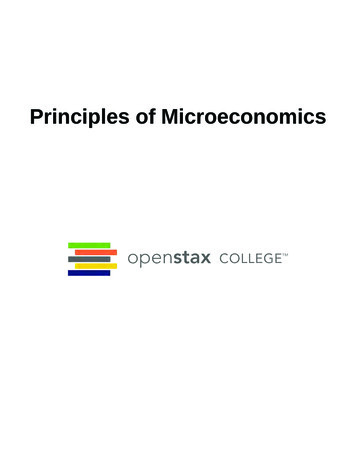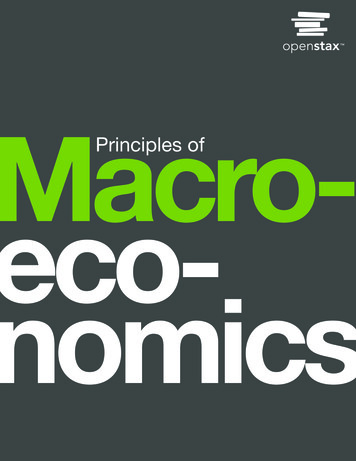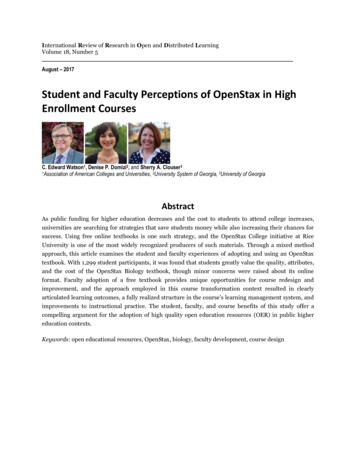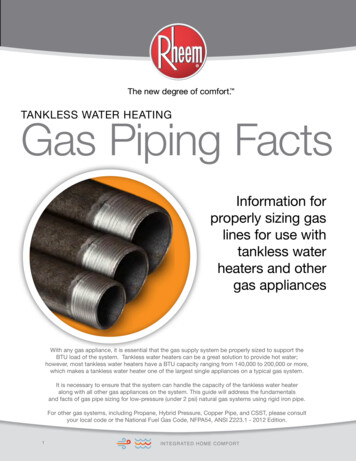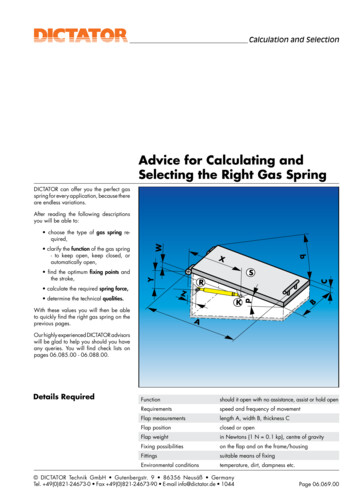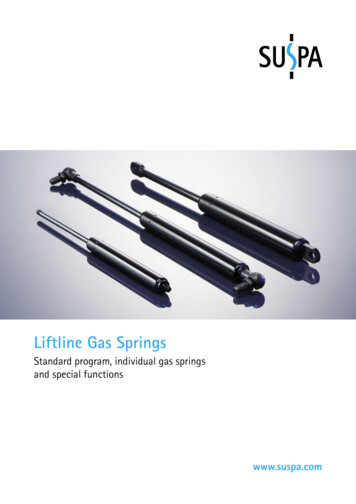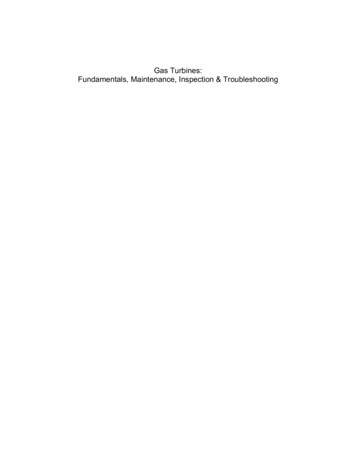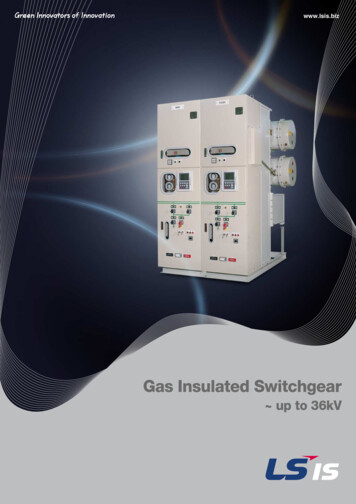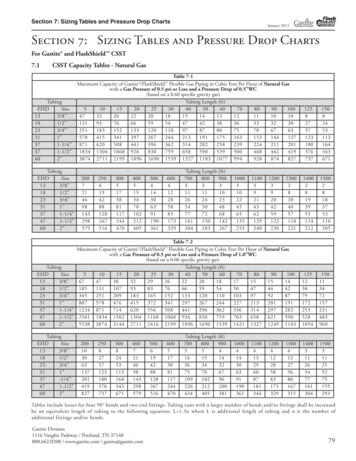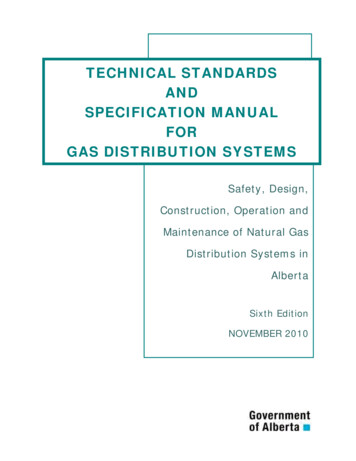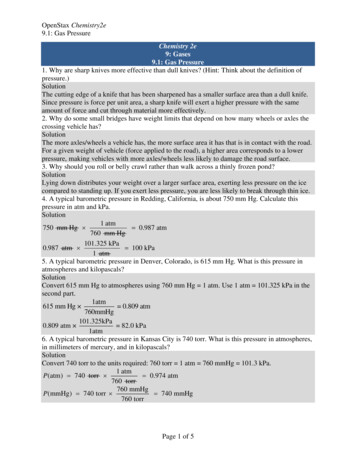
Transcription
OpenStax Chemistry2e9.1: Gas PressureChemistry 2e9: Gases9.1: Gas Pressure1. Why are sharp knives more effective than dull knives? (Hint: Think about the definition ofpressure.)SolutionThe cutting edge of a knife that has been sharpened has a smaller surface area than a dull knife.Since pressure is force per unit area, a sharp knife will exert a higher pressure with the sameamount of force and cut through material more effectively.2. Why do some small bridges have weight limits that depend on how many wheels or axles thecrossing vehicle has?SolutionThe more axles/wheels a vehicle has, the more surface area it has that is in contact with the road.For a given weight of vehicle (force applied to the road), a higher area corresponds to a lowerpressure, making vehicles with more axles/wheels less likely to damage the road surface.3. Why should you roll or belly crawl rather than walk across a thinly frozen pond?SolutionLying down distributes your weight over a larger surface area, exerting less pressure on the icecompared to standing up. If you exert less pressure, you are less likely to break through thin ice.4. A typical barometric pressure in Redding, California, is about 750 mm Hg. Calculate thispressure in atm and kPa.Solution1 atm750 mm Hg 0.987 atm760 mm Hg101.325 kPa0.987 atm 100 kPa1 atm5. A typical barometric pressure in Denver, Colorado, is 615 mm Hg. What is this pressure inatmospheres and kilopascals?SolutionConvert 615 mm Hg to atmospheres using 760 mm Hg 1 atm. Use 1 atm 101.325 kPa in thesecond part.1atm615 mm Hg 0.809 atm760mmHg101.325kPa0.809 atm 82.0 kPa1atm6. A typical barometric pressure in Kansas City is 740 torr. What is this pressure in atmospheres,in millimeters of mercury, and in kilopascals?SolutionConvert 740 torr to the units required: 760 torr 1 atm 760 mmHg 101.3 kPa.1 atmP (atm) 740 torr 0.974 atm760 torr760 mmHgP (mmHg) 740 torr 740 mmHg760 torrPage 1 of 5
OpenStax Chemistry2e9.1: Gas Pressure101.3 kPa 98.6 kPa760 torr7. Canadian tire pressure gauges are marked in units of kilopascals. What reading on such agauge corresponds to 32 psi?Solution1 atm101.325 kPa32.0 lb in 2 2.2 102 kPa 214.7 lb in1 atm8. During the Viking landings on Mars, the atmospheric pressure was determined to be on theaverage about 6.50 millibars (1 bar 0.987 atm). What is that pressure in torr and kPa?Solution1 bar0.987 atm760 torr6.50 mbar 4.88 torr1000 mbar1 bar1 atm1 bar0.987 atm101.325 kPa6.50 mbar 0.650 kPa1000 mbar1 bar1 atm9. The pressure of the atmosphere on the surface of the planet Venus is about 88.8 atm. Comparethat pressure in psi to the normal pressure on earth at sea level in psi.SolutionIdentify: 14.7 psi 1 atm14.7 psi88.8 atm 1.30 103 psi1 atm10. A medical laboratory catalog describes the pressure in a cylinder of a gas as 14.82 MPa.What is the pressure of this gas in atmospheres and torr?SolutionConvert 14.82 MPa into atm.1000 kPa1 atmP (atm) 14.82 MPa 146.3 atm1 MPa101.3 kPa760 torrP (torr) 146.3 atm 1.112 105 torr1 atm11. Consider this scenario and answer the following questions: On a mid-August day in thenortheastern United States, the following information appeared in thelocal newspaper:atmospheric pressure at sea level 29.97 in., 1013.9 mbar.(a) What was the pressure in kPa?(b) The pressure near the seacoast in the northeastern United States is usually reported near 30.0in. Hg. During a hurricane, the pressure may fall to near 28.0 in. Hg. Calculate the drop inpressure in torr.Solution101.325 kPa760 torr 101.5 kPa ; (b) 28.0 in. Hg 711 torr ;(a) 29.97 in. Hg 29.92 in. Hg29.92 in. Hg762 – 711 51 torr drop12. Why is it necessary to use a nonvolatile liquid in a barometer or manometer?SolutionA volatile liquid evaporates easily, which would produce some gas pressure in enclosedvolumes, thus affecting the measurements.P (kPa) 740 torr Page 2 of 5
OpenStax Chemistry2e9.1: Gas Pressure13. The pressure of a sample of gas is measured at sea level with a closed-end manometer. Theliquid in the manometer is mercury. Determine the pressure of the gas in:(a) torr(b) Pa(c) barSolution10 mm1 torr101,325 Pa 264 torr ; (b) 264 torr 35,200 Pa ; (c)1 cm1 mm760 torr1.01325 bar264 torr 0.352 bar760 torr14. The pressure of a sample of gas is measured with anopen-end manometer, partially shown tothe right. The liquid in the manometer is mercury. Assuming atmospheric pressure is 29.92 in.Hg, determine the pressure of the gas in:(a) torr(b) Pa(c) bar(a) 26.4 cm SolutionSince the mercury level is lower in the open arm of the manometer tube, atmospheric pressure isgreater than the trapped gas pressure. The pressure of the gas is therefore calculated bysubtracting the hydrostatic pressure corresponding to a 6 in. column of mercury fromatmospheric pressure. (a) In in. Hg, this is: 29.92 in. Hg – 6.00 in. Hg 23.92 in. Hg,760 torr101325 Pa23.92 in. Hg 608 torr ; (b) 608 torr 81100 Pa ; (c)29.92 in. Hg760 torr1.01325 bar608 torr 0.811 bar760 torrPage 3 of 5
OpenStax Chemistry2e9.1: Gas Pressure15. The pressure of a sample of gas is measured at sea level with an open-end mercurymanometer. Assuming atmospheric pressure is 760.0 mm Hg, determine the pressure of the gasin:(a) mm Hg(b) atm(c) kPaSolutionThe pressure of the gas equals the hydrostatic pressure due to the pressure of the atmosphere atsea level minus a column of mercury of height 13.7 cm. The pressure on the left is due to the gasand the pressure on the right is due to the atmospheric pressure minus 13.7 cm Hg).(a) In mmHg, this is: 760 mm Hg – 137 mmHg 623 mm Hg; (b)1 atm101.325 kPa623 mm Hg 0.820 atm ; (c) 0.820 atm 83.1 kPa760 mm Hg1 atm16. The pressure of a sample of gas is measured at sea level with an open-end mercurymanometer. Assuming atmospheric pressure is 760 mm Hg, determine the pressure of the gas in:(a) mm Hg(b) atm(c) kPaSolution(a) In mm Hg, this is: 760 mm Hg 264 mm Hg 1024 mm Hg; (b)1 atm101.325 kPa1024 mm Hg 1.34 atm ; (c) 1024 mm Hg 136 kPa760 mm Hg760 mm Hg17. How would the use of a volatile liquid affect the measurement of a gas using open-endedmanometers vs. closed-end manometers?SolutionWith a closed-end manometer, no change would be observed, since the vaporized liquid wouldcontribute equal, opposing pressures in both arms of the manometer tube. However, with anPage 4 of 5
OpenStax Chemistry2e9.1: Gas Pressureopen-ended manometer, a higher pressure reading of the gas would be obtained than expected,since Pgas Patm Pvol liquid.This resource file is copyright 2019, Rice University. All Rights Reserved.Page 5 of 5
OpenStax Chemistry 2e9.2: Relating Pressure, Volume, Amount, and Temperature: The Ideal Gas LawChemistry 2e9: Gases9.2: Relating Pressure, Volume, Amount, and Temperature: The Ideal Gas Law18. Sometimes leaving a bicycle in the sun on a hot day will cause a blowout. Why?SolutionThe temperature of the air in the tire increases, which causes the pressure and/or volume toincrease. The volume cannot increase substantially, and high enough pressure can cause the tireto burst.19. Explain how the volume of the bubbles exhausted by a scuba diver (Figure 9.16) change asthey rise to the surface, assuming that they remain intact.SolutionAs the bubbles rise, the pressure decreases, so their volume increases as suggested by Boyle’slaw.20. One way to state Boyle’s law is “All other things being equal, the pressure of a gas isinversely proportional to its volume.”(a) What is the meaning of the term “inversely proportional?”(b) What are the “other things” that must be equal?Solution(a) The pressure increases as the volume decreases and vice-versa. Mathematically, this can be1expressed P V a constant, or P constant . (b) amount of gas and temperature; theVtemperature and the amount (number of moles) of gas must not change21. An alternate way to state Avogadro’s law is “All other things being equal, the number ofmolecules in a gas is directly proportional to the volume of the gas.”(a) What is the meaning of the term “directly proportional?”(b) What are the “other things” that must be equal?Solution(a) The number of particles in the gas increases as the volume increases. This relationship maybe written as n constant V. It is a direct relationship. (b) The temperature and pressure mustbe kept constant.22. How would the graph in Figure 9.12 change if the number of moles of gas in the sample usedto determine the curve were doubled?SolutionThe slope of the line would increase by a factor of 2.23. How would the graph in Figure 9.13 change if the number of moles of gas in the sample usedto determine the curve were doubled?SolutionThe curve would be farther to the right and higher up, but the same basic shape.24. In addition to the data found in Figure 9.13, what other information do we need to find themass of the sample of air used to determine the graph?SolutionThe temperature and the (average) molar mass of air.25. Determine the volume of 1 mol of CH4 gas at 150 K and 1 atm, using Figure 9.12.SolutionThe figure shows the change in volume for 1 mol of CH4 gas as a function of temperature. Thegraph shows that the volume is about 12.5 L.Page 1 of 8
OpenStax Chemistry 2e9.2: Relating Pressure, Volume, Amount, and Temperature: The Ideal Gas Law26. Determine the pressure of the gas in the syringe shown in Figure 9.13 when its volume is12.5 mL, using:(a) the appropriate graph(b) Boyle’s lawSolution(a) The graphical approach requires interpolating a value of pressure, and so the linear plot is1preferred. The volume of 12.5 mL corresponds to an approximate value of 0.065 psi –1 for ,P–1 –1and so the pressure is approximately (0.065 psi ) 15 psi. (b) Any of the pressure-volume datapairs provided in the graph may be used to compute the requested pressure via Boyle’s law. Forexample, using the (15.0 mL, 13.0 psi) data point yields P1V1 P2V213.0 psi 15.0 mLP2 15.6 psi12.5 mL27. A spray can is used until it is empty except for the propellant gas, which has a pressure of1344 torr at 23 C. If the can is thrown into a fire (T 475 C), what will be the pressure in thehot can?SolutionThe first thing to recognize about this problem is that the volume and moles of gas remainconstant. Thus, we can use the combined gas law equation in the form:P2P 1T2T1PT475 273.15P2 1 2 1344 torr 3.40 103 torrT123 273.1528. What is the temperature of an 11.2-L sample of carbon monoxide, CO, at 744 torr if itoccupies 13.3 L at 55 C and 744 torr?SolutionIn this problem, the moles of gas and the pressure remain constant. Therefore, use a relationshipbased on Charles’s law:VV1 V2V kT or k TT1 T2Remember, the temperatures have to be in kelvin.VT13.3 L (3 273.15) KV2 1 2 11.2 LT1(55 273.15) K29. A 2.50-L volume of hydrogen measured at –196 C is warmed to 100 C. Calculate thevolume of the gas at the higher temperature, assuming no change in pressure.SolutionApply Charles’s law to compute the volume of gas at the higher temperature:V1 2.50 LT1 –193 C 77.15 KV2 ?T2 100 C 373.15 KV1 V2 T1 T2Page 2 of 8
OpenStax Chemistry 2e9.2: Relating Pressure, Volume, Amount, and Temperature: The Ideal Gas LawV1T22.50 L 373.15 K 12.1 LT177.15 K30. A balloon inflated with three breaths of air has a volume of 1.7 L. At the same temperatureand pressure, what is the volume of the balloon if five more same-sized breaths are added to theballoon?SolutionUse Avogadro’s law to compute the requested volume. The gas volume added with each breath0.567 L 1.7 Lis 0.567 L, , keeping a nonsignificant “guard digit” to avoid a rounding 3 breaths 1 breath error. If a total of eight breaths are in the balloon, the total volume of gas is:0.567 L 8 breaths 4.5 L .1 breath 31. A weather balloon contains 8.80 moles of helium at a pressure of 0.992 atm and atemperature of 25 C at ground level. What is the volume of the balloon under these conditions?V2 SolutionPV nRTnRT8.80 mol 0.08206 L atm mol 1 K 1 298.15 KV 217 LP0.992 atm32. The volume of an automobile air bag was 66.8 L when inflated at 25 C with 77.8 g ofnitrogen gas. What was the pressure in the bag in kPa?Solution 77.8 g 1 1 28.0135 g mol 1 0.08206 L atm mol K 298.1 K nRT P 1.02 atmV66.8 L101.325 kPaP 1.02 atm 103 kPa1 atm33. How many moles of gaseous boron trifluoride, BF3, are contained in a 4.3410-L bulb at788.0 K if the pressure is 1.220 atm? How many grams of BF3?SolutionPV1.220 atm (4.3410 L)n 0.08190 mol 8.190 10 2 mol 1 1RT(0.08206 L atm mol K )(788.0 K )n molar mass 8.190 10 2 mol 67.8052 g mol 1 5.553 g34. Iodine, I2, is a solid at room temperature but sublimes (converts from a solid into a gas) whenwarmed. What is the temperature in a 73.3-mL bulb that contains 0.292 g of I2 vapor at apressure of 0.462 atm?SolutionPage 3 of 8
OpenStax Chemistry 2e9.2: Relating Pressure, Volume, Amount, and Temperature: The Ideal Gas LawThe molar mass of I2 is 2 126.90447 253.8089 g/mol;PV0.462 atm(0.0733 L)T 359 KnR 0.292 g 1 1 253.8 g mol 1 (0.08206 L atm mol K 35. How many grams of gas are present in each of the following cases?(a) 0.100 L of CO2 at 307 torr and 26 C(b) 8.75 L of C2H4, at 378.3 kPa and 483 K(c) 221 mL of Ar at 0.23 torr and –54 CSolutionIn each of these problems, we are given a volume, pressure, and temperature. We can obtainmoles from this information using the molar mass, m nM, where M is the molar mass:n PV / RTm n (molar mass)P, V , T n, gramsor we can combine these equations to obtain:PVmass m MRT(a)1 atm307 torr 0.4039 atm26 C 299.1 K760 torr;0.4039 atm (0.100 L ) 1 2Mass m 44.01 g mol 7.24 10 g0.08206 L atm mol 1 K 1 (299.1 K )(b)378.3 kPa (8.75 L )Mass m 28.05376 g mol 1 23.1 g ;8.314 L kPa mol 1 K 1 (483 K )(c)1L221 mL 0.221 L 54 C 273.15 219.15 K1000 mL1 atm0.23 torr 3.03 10 4 atm760 torr3.03 10 4 atm (0.221 L )Mass m 39.948 g mol 1 1.5 10 4 g 1 10.08206 L atm mol K (219.15 K )36. A high-altitude balloon is filled with 1.41 104 L of hydrogen at a temperature of 21 C anda pressure of 745 torr. What is the volume of the balloon at a height of 20 km, where thetemperature is –48 C and the pressure is 63.1 torr?SolutionWrite the two sets of conditions in tabular form:P1: 745 torrP2: 63.1 torrT1: 21 C (294.15 K)T2: –48 C (225.15 K)V1: 1.41 104 LV2: ?Writing the data given in this way makes it easy to find the unknown. We can use the ideal gaslaw with the moles of gas (n) held constant:Page 4 of 8
OpenStax Chemistry 2e9.2: Relating Pressure, Volume, Amount, and Temperature: The Ideal Gas LawPV nRTPVPV1 1 nR 2 2T1T2PV75 torr (1.41 102 L)(225.15 K)1 1T2 1.27 105 LT1 P2(294.15 K)(63.1 torr)Note that since R is not required to work the problem, the pressure can be in any pressure unit.The temperature must be in kelvin.37. A cylinder of medical oxygen has a volume of 35.4 L, and contains O2 at a pressure of 151atm and a temperature of 25 C. What volume of O2 does this correspond to at normal bodyconditions, that is, 1 atm and 37 C?SolutionPVPV1 1 2 2T1T2PV TV2 1 1 2T1 P2V2 151 atm 35.4 L 310 K 5561 L 298 K 1 atm 38. A large scuba tank with a volume of 18 L is rated for a pressure of 220 bar. The tank is filledat 20 C and contains enough air to supply 1860 L of air to a diver at a pressure of 2.37 atm (adepth of 45 feet).Was the tank filled to capacity at 20 C?Solution2.37 atm1.01325 bar 2.40 bar11 atmP1V1 P2V2PVP1 2 2V1(2.40 bar)(1860 L )P1 248 bar(18 L )The pressure when the tank was filled is 248 bar, which exceeds the rated pressure of 220 bar, sothe tank was actually overfilled.39. A 20.0-L cylinder containing 11.34 kg of butane, C4H10, was opened to the atmosphere.Calculate the mass of the gas remaining in the cylinder if it were opened and the gas escapeduntil the pressure in the cylinder was equal to the atmospheric pressure, 0.983 atm, and atemperature of 27 C.SolutionCalculate the amount of butane in 20.0 L at 0.983 atm and 27 C. The original amount in thecontainer does not matter.PV0.983 atm 20.0 Ln 0.798 molRT0.08206 L atm mol 1 K 1 (300.1 K )Mass of butane 0.798 mol 58.1234 g/mol 46.4 gPage 5 of 8
OpenStax Chemistry 2e9.2: Relating Pressure, Volume, Amount, and Temperature: The Ideal Gas Law40. While resting, the average 70-kg human man consumes 14 L of pure O2 per hour at 25 Cand 100 kPa. How many moles of O2 are consumed by a 70-kg man while resting for 1.0 h?SolutionUse the ideal gas law: PV nRT0.99 atm 14 L n 0.08226 atm L/mol K 298 K 0.99 atm 14 L n 0.57 mol 0.08226 atm L/mol K 298 K 41. For a given amount of gas showing ideal behavior, draw labeled graphs of:(a) the variation of P with V(b) the variation of V with T(c) the variation of P with T1(d) the variation ofwith VPSolutionFor a gas exhibiting ideal behavior:42. A liter of methane gas, CH4, at STP contains more atoms of hydrogen than does a liter ofpure hydrogen gas, H2, at STP. Using Avogadro’s law as a starting point, explain why.Page 6 of 8
OpenStax Chemistry 2e9.2: Relating Pressure, Volume, Amount, and Temperature: The Ideal Gas LawSolutionOne liter of CH4 and one liter of H2 contain the same number of molecules at STP (Avogadro’slaw), but each CH4 molecule contains four H atoms while each H2 molecule contains two Hatoms.43. The effect of chlorofluorocarbons (such as CCl2F2) on the depletion of the ozone layer is wellknown. The use of substitutes, such as CH3CH2F(g), for the chlorofluorocarbons, has largelycorrected the problem. Calculate the volume occupied by 10.0 g of each of these compounds atSTP:(a) CCl2F2(g)(b) CH3CH2F(g)Solution(a) Determine the molar mass of CCl2F2 then calculate the moles of CCl2F2(g) present. Use theideal gas law PV nRT to calculate the volume of CCl2F2(g):1 mol CCl 2F210.0 g CCl2 F2 0.0827 mol CCl2 F2120.91 g CCl2 F2PV nRT, where n # mol CCl2F20.0821 L atm1 atm V 0.0827 mol 273 K 1.85 L CCl 2 F2 ;mol K1 mol CH 3CH 2 F(b) 10.0 g CH3CH 2 F 0.208 mol CH 3CH 2 F48.07 g CH3CH 2 FPV nRT, with n # mol CH3CH2F1 atm V 0.208 mol 0.0821 L atm/mol K 273 K 4.66 L CH3CH2F44. As 1 g of the radioactive element radium decays over 1 year, it produces 1.16 1018 alphaparticles (helium nuclei). Each alpha particle becomes an atom of helium gas. What is thepressure in pascal of the helium gas produced if it occupies a volume of 125 mL at a temperatureof 25 C?SolutionAfter 1 year, there are:1.16 1018 1.926 10 6 mol28 16.022 10 molFrom the ideal gas law, PV nRT:nRT 1.926 10 6 mol 8.314 L kPa mol 1 K 1 298 KP 3.82 10 2 kPaV0.125 L45. A balloon with a volume of 100.21 L at 21 C and 0.981 atm is released and just barelyclears the top of Mount Crumpet in British Columbia. If the final volume of the balloon is 144.53L at a temperature of 5.24 C, what is the pressure experienced by the balloon as it clears MountCrumpet?SolutionPV PVIdentify the variables in the problem and determine that the combined gas law 1 1 2 2 is theT1T2necessary equation to use to solve the problem. Then solve for P 2:Page 7 of 8
OpenStax Chemistry 2e9.2: Relating Pressure, Volume, Amount, and Temperature: The Ideal Gas Law0.981 atm 100.21 LP 144.53 L 2294 K278.24 atmP2 0.644 atm46. If the temperature of a fixed amount of a gas is doubled at constant volume, what happens tothe pressure?SolutionThe pressure is doubled.47. If the volume of a fixed amount of a gas is tripled at constant temperature, what happens tothe pressure?SolutionThe pressure decreases by a factor of 3.This resource file is copyright 2019, Rice University. All Rights Reserved.Page 8 of 8
OpenStax Chemistry 2e9.3: Stoichiometry of Gaseous Substances, Mixtures, and ReactionsChemistry 2e9: Gases9.3: Stoichiometry of Gaseous Substances, Mixtures, and Reactions48. What is the density of laughing gas, dinitrogen monoxide, N2O, at a temperature of 325 Kand a pressure of 113.0 kPa?Solution113.0 kPa (2 14.00674 15.9994) g mol 1PM 1.84 g L 1 1 1RT8.314 L kPa mol K 325 K49. Calculate the density of Freon 12, CF2Cl2, at 30.0 C and 0.954 atm.Solution0.954 atm 12.011 2 18.9954 2 35.453 g mol 1PM 4.64 g L 1 1 1RT0.08206 L atm mol K 303.15 K50. Which is denser at the same temperature and pressure, dry air or air saturated with watervapor? Explain.SolutionDry air is denser; it has a larger molecular mass. Since density is mass per unit volume, at agiven temperature and pressure, n is a constant. Thus, a given volume will have the same numberof moles of gas. Therefore, if the air becomes moist while the pressure, temperature, and volumeremain the same, then some of the O2 and N2 molecules will be replaced by H2O molecules tokeep the total number of moles of gas the same. Because the molar mass of H2O is less than thatof O2 and N2, the air becomes less dense. Thus, air saturated with water vapor is less dense.Therefore, dry air is denser.51. A cylinder of O2(g) used in breathing by patients with emphysema has a volume of 3.00 L ata pressure of 10.0 atm. If the temperature of the cylinder is 28.0 C, what mass of oxygen is inthe cylinder?Solution(31.9988 g mol 1 )(10.0 atm )(3.00 L )mass O 2 38.8 g(0.08206 L atm mol 1 K 1 )(301.15 K )52. What is the molar mass of a gas if 0.0494 g of the gas occupies a volume of 0.100 L at atemperature 26 C and a pressure of 307 torr?SolutionmassFrom the ideal gas law, PV nRT, set n and solve for the molar mass.molar mass(0.0494 g)(0.08206 L atm mol 1 K 1 )(299.15 K )molar mass 30.0 g mol 1307 torr (0.1 L ) 1 760 torr atm 53. What is the molar mass of a gas if 0.281 g of the gas occupies a volume of 125 mL at atemperature 126 C and a pressure of 777 torr?SolutionmassFrom the ideal gas law, PV nRT, set n and solve the molar mass.molar massPage 1 of 12
OpenStax Chemistry 2e9.3: Stoichiometry of Gaseous Substances, Mixtures, and Reactions(0.281 g)(0.08206 L atm mol 1 K 1 )(399.15 K )molar mass 72.0 g mol 1777 torr 760 torr atm 1 (0.125 L ) 54. How could you show experimentally that the molecular formula of propene is C3H6, notCH2?SolutionA person could measure the mass, volume, and pressure of the gas and calculate the molar massfrom the ideal gas equation. C3H6 will have three times the molar mass expected for CH2.55. The density of a certain gaseous fluoride of phosphorus is 3.93 g/L at STP. Calculate themolar mass of this fluoride and determine its molecular formula.SolutionmRTmDRTM D M PVVP3.93 g L 1 (0.08206 L atm mol 1 K 1 )(273.15 K ) 88.1 g mol 11.00 atmMphosphorous 30.97376 g/molMfluorine 18.998403 g/molmolecular formula: phosphorous: 30.97376fluorine: 3(18.998403)M 87.968969The molecular formula is PF3.To find this answer you can either use trial and error, or you can realize that since phosphorus isin group 5, it can fill its valence shell by forming three bonds. Fluorine, being in group 7, needsto form only one bond to fill its shell. Thus it makes sense to start with PF3 as a probableformula.56. Consider this question: What is the molecular formula of a compound that contains 39% C,45% N, and 16% H if 0.157 g of the compound occupies 125 mL with a pressure of 99.5 kPa at22 C?(a) Outline the steps necessary to answer the question.(b) Answer the question.Solution(a) Determine the empirical formula of the compound from the percent composition. Determinethe molar mass from the mass of the sample and its volume, temperature, and pressure. Thendetermine the molecular formula from the molar mass and the empirical formula.(b) Assume that a 100.0-g sample is present and the percentages translate directly to grams of thesample.1 mol CC: 39 g 3.247 mol C12.011 g mol –11 mol HH: 16 g 15.874 mol H1.00794 g mol –11 mol NN: 45 g 3.213 mol N14.00674 g mol –1Page 2 of 12
OpenStax Chemistry 2e9.3: Stoichiometry of Gaseous Substances, Mixtures, and ReactionsDivide each quantity by the smallest value. After rounding, the values are 1C, 5H, and 1N. Theempirical formula is CH5N. The empirical mass is CH5N 31. The likely arrangement ofhydrogen atoms is CH3NH2.Now the molar mass from the ideal gas law:mass RTmolar mass PV(0.157 g)(8.314 L kPa mol 1 K 1 )(295.15 K ) 99.5 kPa 0.125 L 1 31.0 g molThe empirical formula is the molar formula, CH3NH2.57. A 36.0–L cylinder of a gas used for calibration of blood gas analyzers in medical laboratoriescontains 350 g CO2, 805 g O2, and 4,880 g N2. At 25 C, what is the pressure in the cylinder inatmospheres, in torr, and in kilopascals?SolutionCalculate the moles of each gas present and from that, calculate the pressure from the ideal gaslaw. Assume 25 C. The calibration gas contains:350 g CO2 7.953 mol CO244.0098 g mol 1 CO2805 g O 2 25.157 mol O231.9988 g mol 1 O 24880 g N 2 174.202 mol N 228.01348 g mol 1 N 2Total moles 7.953 25.157 174.202 207.312 molnRT207.312 mol 0.08206 L atm mol 1 K 1 298.15 KP 141 atmV36.0 LP in torr 107,000 torrP in kPa 14,300 kPa58. A cylinder of a gas mixture used for calibration of blood gas analyzers in medicallaboratories contains 5.0% CO2, 12.0% O2, and the remainder N2 at a total pressure of 146 atm.What is the partial pressure of each component of this gas? (The percentages given indicate thepercent of the total pressure that is due to each component.)SolutionThe calibration gas contains:5.0% CO212.0% O2100 – (5 12) 83% N2Since these are percentages of the total pressure, the partial pressures can be calculated asfollows:CO2: 5% of 146 atm 0.05 146 7.3 atm 7 atmO2: 12% of 146 atm 0.12 146 17.5 atm 18 atmN2: 83% of 146 atm 0.83 146 121 atm 1.2 102 atm59. A sample of gas isolated from unrefined petroleum contains 90.0% CH4, 8.9% C2H6, and1.1% C3H8 at a total pressure of 307.2 kPa. What is the partial pressure of each component ofPage 3 of 12
OpenStax Chemistry 2e9.3: Stoichiometry of Gaseous Substances, Mixtures, and Reactionsthis gas? (The percentages given indicate the percent of the total pressure that is due to eachcomponent.)SolutionSince these are percentages of the total pressure, the partial pressure can be calculated as follows:CH4: 90% of 307.2 kPa 0.900 307.2 276 kPaC2H6: 8.9% of 307.2 kPa 0.089 307.2 27 kPaC3H8: 1.1% of 307.2 kPa 0.011 307.2 3.4 kPa60. A mixture of 0.200 g of H2, 1.00 g of N2, and 0.820 g of Ar is stored in a closed container atSTP. Find the volume of the container, assuming that the gases exhibit ideal behavior.SolutionFirst find the number of moles of gases present.0.200 gH2: 0.0992 mol2.016 g mol 11.00 gN2: 0.0357 mol28.013 g mol 10.820 gAr: 0.0205 mol39.948 g mol 1The total amount of substance is 0.1555 mol.nRT0.155 mol 0.08206 L atm mol 1 K 1 273.15 KV 3 .474 LP1.00 atm61. Most mixtures of hydrogen gas with oxygen gas are explosive. However, a mixture thatcontains less than 3.0 % O2 is not. If enough O2 is added to a cylinder of H2 at 33.2 atm to bringthe total pressure to 34.5 atm, is the mixture explosive?SolutionThe oxygen increases the pressure within the tank to (34.5 atm – 33.2 atm ) 1.3 atm. The1.3percentage O2 on a mole basis is 100% 3.77%. The mixture is explosive. However, the34.5percentage is given as a weight percent. Converting to a mass basis increases the percentage ofoxygen even more, so the mixture is still explosive.62. A commercial mercury vapor analyzer can detect, in air, concentrations of gaseous Hg atoms(which are poisonous) as low as 2 10–6 mg/L of air. At this concentration, what is the partialpressure of gaseous mercury if the atmospheric pressure is 733 torr at 26 C?SolutionThe total pressure is the pressure of the normal atmospheric components plus that due tomercury. Use the ideal gas equation to calculate the total number of moles of gas required toproduce the stated conditions. The pressure of mercury is the mole fraction of mercury times thetotal pressure:Page 4 of 12
OpenStax Chemistry 2e9.3: Stoichiometry of Gaseous Substances, Mixtures, and Reactionsmol (Hg) 2 10 6 mg L 1 nT1 g1 mol 9.97 10 12 mol L 11000 mg200.59 g 733 (1.0 L )PV760 atm 0.0400 molRT(0.08206 L atm mol 1 K 1 )(294.15 K )9.97 10 12 mol733 torr 2.4 10 10 atm0.0400 mol760 torr atm 1 2.4 10 10 atm 760 torr atm 1P(Hg) 2 10 7 torr63. A sample of carbon monoxide was collected over water at a total pressure of 756 torr and atemperature of 18 C. What is the pressure of the carbon monoxide? (See Table 9.2 for the vaporpressure of water.)SolutionThe vapor pressure of water at 18 C is 15.5 torr. Subtract the vapor pressure of water from thetotal pressure to find the pressure of the carbon monoxide:PT Pgas PwaterRearrangement gives:PT – Pwater Pgas756 torr – 15.5 torr 740 torr64. In an experiment in a general chemistry laboratory, a student collected a sample of a gas overwater. The volume of the gas was 265 mL at a pressure of 753 torr and a temperature of 27 C.The mass of the gas was 0.472 g. What was the molar mass of the gas?SolutionFirst, find the water vapor pressure at 27 C and subtract it from the measured pressure. From arearranged form of the ideal gas equation, find the molar mass of the gas:0.472 g 0.08206 L atm mol 1 K 1 303.15 Kmolar mass 46.4 g mol 1726 torratm 1 0.265 L760 torr65. Joseph Priestley first prepared pure oxygen by heating mercuric oxide, HgO:2HgO(s) 2Hg(l ) O2 ( g )(a) Outline the steps necessary to answer the following question: What volume of O2 at 23 Cand 0.975 atm is produced by the decomposition of 5.36 g of HgO?(b) Answer the question.Solution(a) Determine the moles of HgO that decompose; using the chemical equation, determine themoles of O2 produced by decomposition of this amount of HgO; and determine the volume of O 2from the moles of O2, temperature, and pressure.(b)1 mol HgO 0.0247
9.2: Relating Pressure, Volume, Amount, and Temperature: The Ideal Gas Law Page 2 of 8 26. Determine the pressure of the gas in the syringe shown in Figure 9.13 when its volume is 12.5 mL, using: (a) the appropriate graph (b) Boyle’s law Solution (a) The graphical approach requires int
